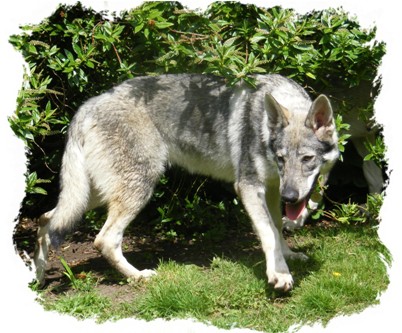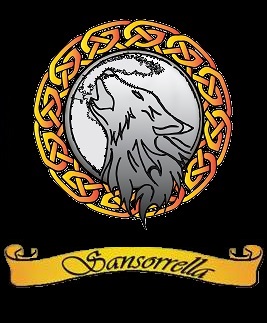(Nr.332/03.09.1999)
ORIGIN:
Former Czechoslovakian Republic
UTILIZATION:
Working Dog.
CLASSIFICATION F.C.I.:
Group 1 (Sheepdogs and Cattle Dogs)
Section 1 (Sheepdogs with Working Trial)
BRIEF HISTORICAL SUMMARY:
In the year 1955 a biological experiment took place in the CSSR of that
time, namely, the crossing of a German Shepherd Dog with a Carpathian
wolf. The experiment established that the progeny of the mating of male
dog to female wolf as well as that of male wolf to female dog, could be
reared. The overwhelming majority of the products of these matings
possessed the genetic requirements for continuation of breeding. In the
year 1965, after the ending of the experiment, a plan for the breeding
of this new breed was worked out. This was to combine the usable
qualities of the wolf with the favourable qualities of the dog. In the
year 1982, the Czechoslovakian Wolfdog, through the general committee of
the breeder's associations of the CSSR of that time, was recognized as a
national breed.
GENERAL APPEARANCE:
Firm type in constitution. Above average size with rectangular frame. In
body shape, movement, coat texture, colour of coat and mask, similar to
the wolf.
IMPORTANT PROPORTIONS:
Length of body : Height at Withers : 10 : 9
Length of muzzle : Length of cranial region : 1 : 1.5.
BEHAVIOUR-TEMPERAMENT:
Lively, active, tough, obedient with quick reactions, fearless and
courageous. Shows tremendous loyalty towards his master. Resistant to
weather conditions. Versatile in his uses.
HEAD
Symmetrical, well muscled. Seen from the side and from above, it forms a
blunt wedge. Sex should be unmistakable.
CRANIAL REGION:
Seen from the side and from the front, the forehead is slightly arched.
No marked frontal furrow. Occipital bone clearly visible.
Stop: Moderate.
FACIAL REGION:
Nose: Oval shape, black.
Muzzle: Clean, not broad, straight bridge of nose.
Lips: Tight fitting. No gap at corner of mouth. Rims of
lips are black.
Jaws/Teeth: Jaws strong and symmetrical. Well developed
teeth, specially the canines. Scissor or pincer bite with 42 teeth
according to the usual tooth formation. Regular teeth set.
Cheeks: Clean, sufficiently muscled, not markedly
protruding.
Eyes: Small, slanting, amber coloured. Close fitting
lids.
Ears: Pricked, thin, triangular, short (i.e. not longer
than 1/6th of height at withers); the lateral point of the set on of the
ears and the outer corner of the eyes are in a direct line. A vertical
line from tip of ear would run close along the head.
NECK
Dry, well muscled. In repose forms an angle of up to 40 degrees to
the horizontal. The neck must be sufficiently long for the nose to touch
the ground effortlessly.
BODY
Topline: Flowing transition from neck to body.
Sloping away slightly.
Withers: Well muscled, pronounced. Though pronounced,
they must not interrupt the flow of the top line.
Back: Firm and straight.
Loins: Short, well muscled, not broad, sloping
slightly.
Croup: Short, well muscled, not broad, falling away
slightly.
Chest: Symmetrical, well muscled, roomy, pear shaped
and narrowing towards the sternum. The depth of chest does not reach to
the elbows. The point of the sternum does not extend beyond the shoulder
joints.
Lower line and belly: Taut belly, tucked up. Slightly
hollow in flanks.
TAIL
Set on high, hanging straight down. When dog is excited, generally
raised up in sickle shape.
LIMBS
FOREQUARTERS: The front legs are straight, clean,
close together with slightly turned out feet.
Shoulders: The shoulder-blade is placed rather far
forward, well muscled. It forms an angle of nearly 65 degrees to the
horizontal.
Upper arm: Strongly muscled, forms an angle of 120 to
130 degrees to the shoulder-blade.
Elbows: Close fitting, turned neither in nor out, well
defined, flexible. Upperarm and forearm form an angle of approximately
150 degrees.
Forearm: Long, clean and straight. The length of the
forearm and pastern is 55% of height at withers.
Pastern joint: Solid, flexible.
Pastern: Long, forms an angle of at least 75 degrees to
the ground. Lightly springy in movement.
Front feet: Large, turned slightly outwards. Longish
arched toes and strong, dark nails. Well defined, elastic, dark pads.
HINDQUARTERS
Powerful. The hind legs stand parallel. An imaginary vertical line
drawn from the point of the ischium, would run midway through the hock
joint. Dew-claws not desirable and should be removed.
Upper thigh: Long, well muscled. Forms an angle of 80
degrees to the pelvis. The hip joint is sturdy and flexible.
Knee: Strong, flexible.
Lower thigh: Long, clean, well muscled. Forms an angle
of about 130 degrees with the metatarsus.
Hock joint: Clean, solid, flexible.
Hocks: Long, clean. Position almost vertical to the
ground.
Hind feet: Longish, arched toes with strong dark nails.
Well defined pads.
MOVEMENT
Harmonious, light footed, ground covering trot in which the limbs
skim over the ground as closely as possible. Head and neck incline to
the horizontal. Pacing when walking.
SKIN
Elastic, tight, without wrinkles, unpigmented.
COAT
MAKE UP OF COAT: Straight, close. Winter and
summer coat differ greatly. In winter an immense undercoat together with
the topcoat, forms a thick coat all over the body. It is necessary for
the hair to cover the belly, the inside of the upper thigh, the scrotum,
the inner part of the ears and the area between the toes. Well coated
neck.
COLOUR:
Yellowish-gray to silver-gray with a characteristic light mask. Light
hair also on the underside of the neck and the forechest. Dark gray
colour with mask is permissible.
HEIGHT AND WEIGHT
Height at Withers:
Dogs at least 65 cm
Bitches at least 60 cm
Weight:
Dogs at least 26 kg
Bitches at least 20 kg
FAULTS :
Any departure from the foregoing points should be considered a fault,
and the seriousness with which the fault should be regarded should be in
exact proportion to its degree.
- Heavy or light head.
- Flat forehead.
- Missing 2 PM1 or both M3 should not be considered as a fault. If
additionally for missing two PM1 also one M3 is missing or for missing
M3 also one PM1 is missing, it should be judged as a fault.
- Dark brown, black or different coloured eyes.
- Coarse ear. High or low set on of ear.
- Neck carried high in repose; low position of neck when standing.
- Unpronounced withers.
- Untypical topline.
- Long croup.
- Tail long, set on low and not carried correctly.
- Too little or too much angulation in forequarters.
- Weak pastern.
- Too little or too much angulation in hindquarters. Insufficient
muscle.
- Barely pronounced mask.
- Short wavy movement.
DISQUALIFYING FAULTS
:
- Aggressive or overly shy.
- Discrepancy in proportions.
- Faults in deportment and temperament.
- Untypical head.
- Missing teeth (beside 2 PM1 and M3, see § FAULTS). Irregular bite.
- Untypical shape and position of eye.
- Untypical set on and shape of ears.
- Dewlap.
- Strong slope in croup.
- Untypical ribcage.
- Tail untypical in set on and carriage.
- Faulty and untypical position of front legs.
- Stand -off and untypical coat.
- Colours other than those in the standard.
- Slack ligaments.
- Untypical movement.
Any dog clearly showing physical or behavioural abnormalities shall
be disqualified.
N.B.
: Male dogs must have two apparently normal testicles
fully descended into the scrotum.









![]() Sansorrella 2010 All rights reserved
Sansorrella 2010 All rights reserved